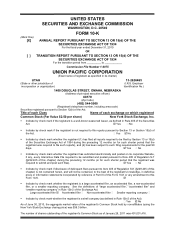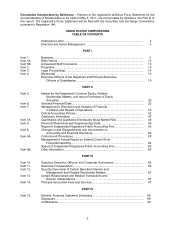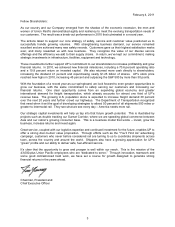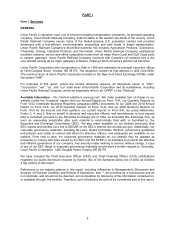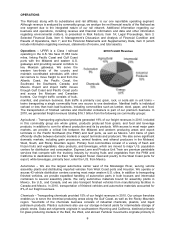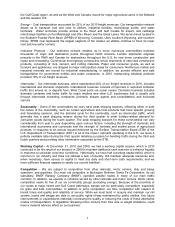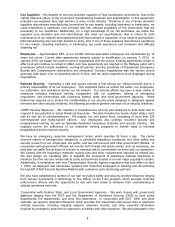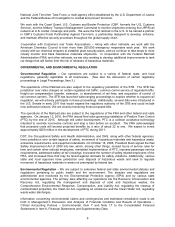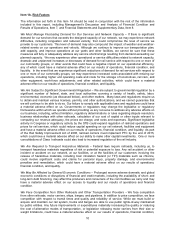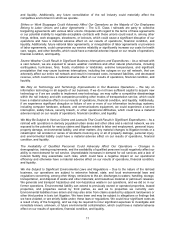Union Pacific 2010 Annual Report Download - page 8
Download and view the complete annual report
Please find page 8 of the 2010 Union Pacific annual report below. You can navigate through the pages in the report by either clicking on the pages listed below, or by using the keyword search tool below to find specific information within the annual report.8
Key Suppliers – We depend on two key domestic suppliers of high horsepower locomotives. Due to the
capital intensive nature of the locomotive manufacturing business and sophistication of this equipment,
potential new suppliers face high barriers to entry in this industry. Therefore, if one of these domestic
suppliers discontinues manufacturing locomotives for any reason, including insolvency or bankruptcy, we
could experience a significant cost increase and risk reduced availability of the locomotives that are
necessary to our operations. Additionally, for a high percentage of our rail purchases, we utilize two
suppliers (one domestic and one international) that meet our specifications. Rail is critical for both
maintenance of our network and replacement and improvement or expansion of our network and facilities.
Rail manufacturing also has high barriers to entry, and, if one of those suppliers discontinues operations
for any reason, including insolvency or bankruptcy, we could experience cost increases and difficulty
obtaining rail.
Employees – Approximately 86% of our 42,884 full-time-equivalent employees are represented by 14
major rail unions. Current labor agreements became subject to modification on January 1, 2010. In
January 2010, we began the current round of negotiations with the unions. Existing agreements remain in
effect and will continue to remain in effect until new agreements are reached or the Railway Labor Act’s
procedures (which include mediation, cooling-off periods, and the possibility of Presidential Emergency
Boards and Congressional intervention) are exhausted. Contract negotiations with the various unions
generally take place over an extended period of time, and we rarely experience work stoppages during
negotiations.
Railroad Security – Operating a safe and secure railroad is first among our critical priorities and is a
primary responsibility of all our employees. This emphasis helps us protect the public, our employees,
our customers, and operations across our rail network. Our security efforts rely upon a wide variety of
measures including employee training, cooperation with our customers, training of emergency
responders, and partnerships with numerous federal, state, and local government agencies. While
federal law requires us to protect the confidentiality of our security plans designed to safeguard against
terrorism and other security incidents, the following provides a general overview of our security initiatives.
UPRR Security Measures – We maintain a comprehensive security plan designed to both deter and to
respond to any potential or actual threats as they arise. The plan includes four levels of alert status, each
with its own set of countermeasures. We employ our own police force, consisting of more than 225
commissioned and highly-trained officers. Our employees also undergo recurrent security and
preparedness training, as well as federally-mandated hazardous materials and security training. We
regularly review the sufficiency of our employee training programs to identify ways to increase
preparedness and to improve security.
We have an emergency response management center, which operates 24 hours a day. The center
receives reports of emergencies, dangerous or potentially dangerous conditions, and other safety and
security issues from our employees, the public, and law enforcement and other government officials. In
cooperation with government officials, we monitor both threats and public events, and, as necessary, we
may alter rail traffic flow at times of concern to minimize risk to communities we serve and our operations.
We comply with the hazardous materials routing rules and other requirements imposed by federal law.
We also design our operating plan to expedite the movement of hazardous material shipments to
minimize the time rail cars remain idle at yards and terminals located in or near major population centers.
Additionally, in compliance with new Transportation Security Agency regulations that took effect on April
1, 2009, we deployed new information systems and instructed employees in tracking and documenting
the handoff of Rail Security Sensitive Material with customers and interchange partners.
We also have established a number of our own innovative safety and security-oriented initiatives ranging
from various investments in technology to The Officer on the Train program, which provides local law
enforcement officers with the opportunity to ride with train crews to enhance their understanding of
railroad operations and risks.
Cooperation with Federal, State, and Local Government Agencies – We work closely with government
agencies ranging from the DOT and the Department of Homeland Security (DHS) to local police
departments, fire departments, and other first responders. In conjunction with DOT, DHS, and other
railroads, we sponsor Operation Respond, which provides first responders with secure links to electronic
railroad resources, including mapping systems, shipment records, and other essential information
required by emergency personnel to respond to accidents and other situations. We also participate in the

